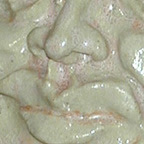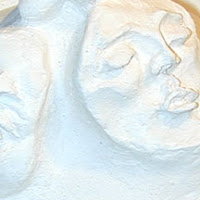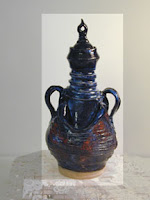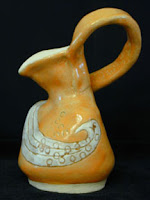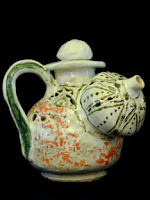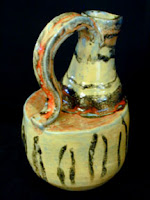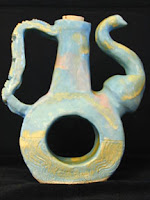Yesterday fired these pots under the assumption, that while i've never been able to get the Olympic Torchbearer 1827G to reach temps of 2167°F, it has consistently heated beyond temps of 2012°F. Since, both the electric and gas kilns seem to be in cahoots with each other, i've been trying to modify my cone 5-6 glazes to accomodate the kilns.
OK. Here's the scoop. Arranged the shelves in the kiln totally differently than previous attempts. Used 2 half shelves placed 3.5 inches from the bottom. Put 2 more half shelves on 10-inch posts and balanced them on the first set. Put the 4 bowls on these shelves. Then, balanced a full shelf on more 10-inch posts which placed it 4.5-inches from the top.
The air-intake valves were approximately 1/8th-inch from the closed position. The draft at the top was covered to approx. 1/3rd of the opening.
The first peephole would have been measuring heat of pots on the bottom half shelves (if any had been placed there). The second peephole measured the heat of the middle set of half shelves, and the third peephole measured the heat in the space above the top shelf. One should probably pay attention to these type of details before they fire a load. Me? I arranged the shelves and the pots. The hour was midnight and did i mention that i was already exhausted? Yesterday morning at 6am, as i fired the kiln, wondered why the pyrometer was giving me three different sets of readings: top peephole read 2150°F, middle read 2050°F, bottom read 2000°F. Which one of the three i should be paying attention to !!!
This morning, after removing the bowls, i measured both the shelf spaces and the peephole openings. An ounce of precalculation is worth a pound of cure, they say. But i lucked out.
xxxxxxxxxxxxxxxxxxx 
I should mention here, if you're gonna try out new glaze recipes, try not to concoct them when you're positively exhausted and your mind is laboring to overcome a dull, throbbing headache. It's not that you can't build a perfectly wonderful glaze computation which turns out swell and nicely vitrified !!! It's that after you have done so and fired them, you find you've forgotten to meticulously write down the ingredients in a logical and repeatable order!
So! To the best of my dead- (tired) reckoning, here is a recipe that will vitrify at temps between 2020°F and 2050°F:
Neph Sye = 10
Frit 3110 = 50
Bone Ash = 5.5
Magnesium = 3.1
Dolomite = 7.7
Lithium = 5.5
EPK = 5
Silica = 7
Talc = 6
xxxxxxxxxxxxxx 
The outside of this bowl has the above recipe (base) with 4 parts Zinc added. Let's call this: (#A). It's a satiny matte.

The inside glaze is a combination of the above recipe (base) with (#B) which has 4 parts Rutile and 1 part Red Iron Oxide added. Then, an additional overlay of the glaze (#A) with the zinc was added. It's super glossy and quite attractive in its own way.
Now . . . here comes the part about inadequate notes. A few days ago, fired a recipe high in manganese content trying to produce a lustre glaze. Fired 3 different bowls with 3 different amounts of manganese on the inside with different glazes on the outside. One had antimony; one had potassium dichromate. While all the glazes vitrified at 2020°F in the electric kiln (oxidation), they were not pretty. Dull matte surfaces. No lustre.
Naturally, i thought - well - they needed a reduction atmosphere. Put them in yesterday's firing. Since they were formulated for temps of 1999°F to 2020°F, most of the glaze surfaces boiled at 2050°F. Some did not, which is confusing in and of itself !!! But it's the color we're interested in here.
Note:

On the bottom bowl: the potassium dichromate turned a putrid green in reduction. Not cool when in theory it was spozed to be an orangy-red.
The top bowl with the antimony on the outside turned ugly shades of gray sprinkled with white.
However !!!
The inside of this bowl which had been a dull metallic gray and originally glazed with:
Manganese = 36
Gerstley = 32
Lead Bisilicate = 20
Frit 3110 = 4
Red Art = 4
With the addition of Glaze recipe #A ( 4 parts Zinc) liberally brushed over the pre-fired surface and fired in reduction, turned glossy with rich red-highlighted tenmoku coloring !!!

This isn't the greatest picture of it; the one above shows the richness of color and glossiness better.
So! There you have it. Such as they are, notes on firing gas kilns and metallic lustres which didn't luster and cone 03 to cone 1 glazes which did vitrify, amidst notes on overlaying glazes.
If you're not ready to throw in the towel by now, stay with me. More notes on experimental glazes to follow when formulated and fired !!!
Chae

